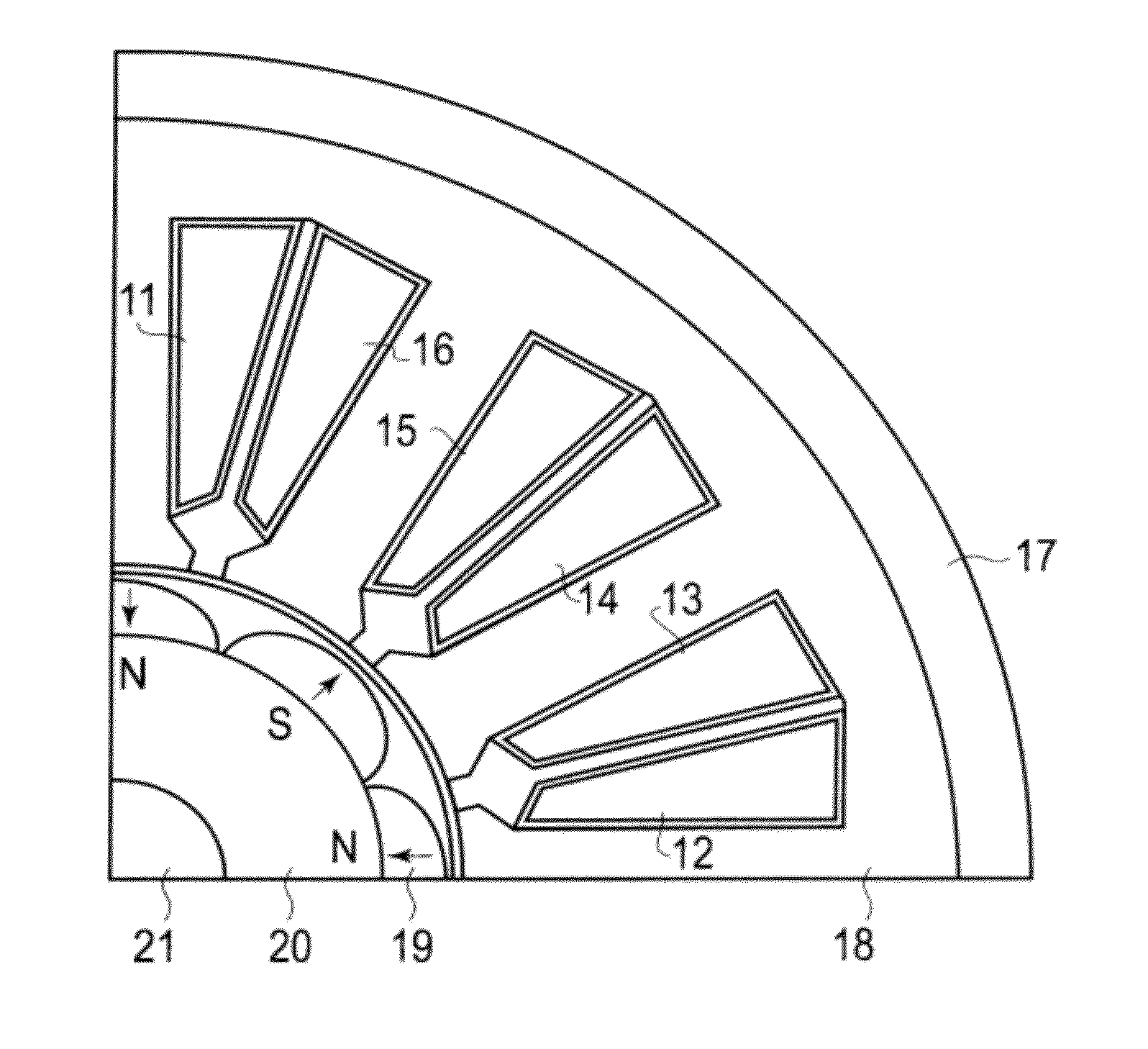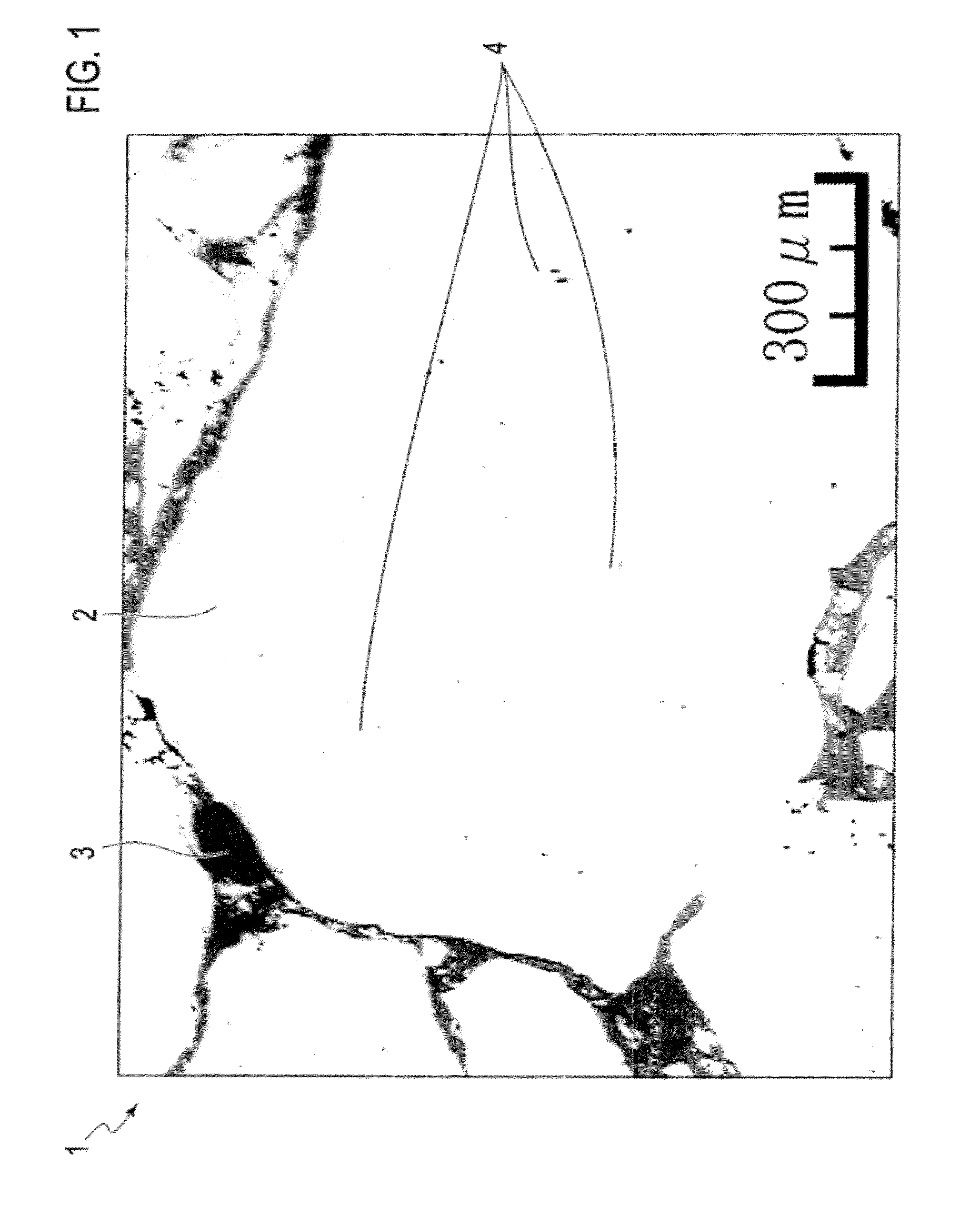Rare earth magnet molding and method for manufacturing the same
a rare earth magnet and molding technology, applied in the field of magnet molding, can solve the problems of affecting the quality of the magnet particles, and the inability to maintain excellent magnetic characteristics, etc., to achieve the effect of reducing the area of the interface at which the chemical reaction is caused, increasing the rate of inner defects that inhibit the magnetic characteristics of the magnet particles, and relatively reducing the influence of degradation on the magnetic characteristics
- Summary
- Abstract
- Description
- Claims
- Application Information
AI Technical Summary
Benefits of technology
Problems solved by technology
Method used
Image
Examples
example 1
[0111]Powder of a Nd—Fe—B type anisotropic magnet prepared by means of an HDDR method was used as raw material magnetic powder. Specific procedures for preparation are as follows.
[0112]First, an ingot having a composition defined as “Nd: 12.6%, Co: 17.4%, B: 6.5%, Ga: 0.3%, Al: 0.5%, Zr: 0.1%, and Fe: balance (% by mass)” was prepared. The ingot was retained at 1120° C. for 20 hours for homogenization. The homogenized ingot was then heated from a room temperature up to 500° C. and retained at the same temperature in a hydrogen atmosphere, and then further heated up to 850° C. and retained at the same temperature.
[0113]Subsequently, the ingot was retained at 850° C. in vacuum, and then cooled down to obtain an alloy including a fine ferromagnetic phase recrystallization texture. The alloy was powdered under an argon atmosphere by means of a jaw crusher and a braun mill and thereby formed into rare earth magnet raw material magnetic powder having an average particle diameter of 300 μm...
example 2
[0129]A rare earth magnet molding was obtained in the same manner as Example 1 except that praseodymium tri-isopropoxide was used instead of dysprosium tri-isopropoxide as rare earth alkoxide to form an insulating phase containing Pr oxide. The concentration of Pr in the praseodymium surface treating solution was analyzed by means of ICP. The coating amount of the solution was adjusted in such a manner that the amount was 40 mg in total with respect to 10 g of the magnet particles.
example 3
[0130]A rare earth magnet molding was obtained in the same manner as Example 1 except that raw material magnetic powder for a sintered magnet was used instead of the raw material magnetic powder prepared by means of the HDDR method. The raw material magnetic powder was prepared as follows.
[0131]An alloy mixed to have a composition defined as Nd: 31.8, B: 0.97, Co: 0.92, Cu: 0.1, Al: 0.24, and balance: Fe (% by mass) was processed into an alloy ribbon having a thickness of 0.2 mm to 0.3 mm by means of a strip cast method. Subsequently, a container was filled with the alloy ribbon and placed in a hydrogen treating device. The hydrogen treating device was filled with a hydrogen gas atmosphere with pressure of 500 kPa so that hydrogen was adsorbed to the alloy ribbon at room temperature. Then, the atmosphere was converted into argon gas, and the pressure was decreased to 10−5 Pa to release hydrogen. Through such hydrogen treatment, the alloy ribbon was processed into amorphous powder ha...
PUM
| Property | Measurement | Unit |
|---|---|---|
| particle diameter | aaaaa | aaaaa |
| particle diameter | aaaaa | aaaaa |
| particle diameter | aaaaa | aaaaa |
Abstract
Description
Claims
Application Information
 Login to View More
Login to View More - R&D
- Intellectual Property
- Life Sciences
- Materials
- Tech Scout
- Unparalleled Data Quality
- Higher Quality Content
- 60% Fewer Hallucinations
Browse by: Latest US Patents, China's latest patents, Technical Efficacy Thesaurus, Application Domain, Technology Topic, Popular Technical Reports.
© 2025 PatSnap. All rights reserved.Legal|Privacy policy|Modern Slavery Act Transparency Statement|Sitemap|About US| Contact US: help@patsnap.com



